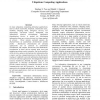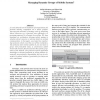ISADS
2003
IEEE
14 years 8 months ago
2003
IEEE
In many ubiquitous computing (ubicomp) applications, such as smart classrooms, hospitals, construction sites, stadiums, shopping malls, emergency services, law enforcement, conven...
ISADS
2003
IEEE
14 years 8 months ago
2003
IEEE
ISADS
2003
IEEE
14 years 8 months ago
2003
IEEE
In the future, intelligent sensors will connected through networks, each node have its own autonomy, heterogeneity, and under dynamic environments. We call these systems as a Hete...
ISADS
2003
IEEE
14 years 8 months ago
2003
IEEE
An advanced high-level approach for programming of real-time distributed computing applications, the TMO (Time-triggered Message-triggered Object) programming and specification sc...
ISADS
2003
IEEE
14 years 8 months ago
2003
IEEE
ISADS
2003
IEEE
14 years 8 months ago
2003
IEEE
This paper shows how modern structuring techniques can be employed in integrating complex web applications such as Travel Agency systems. The main challenges the developers of suc...
ISADS
2003
IEEE
14 years 8 months ago
2003
IEEE
Maintaining mobile agent availability in the presence of agent server crashes is a challenging issue since developers normally have no control over remote agent servers. A popular...
ISADS
2003
IEEE
14 years 8 months ago
2003
IEEE
ct This paper introduces the Patia Adaptive Webserver architecture, which is distributed and consists of semi-autonomous agents called FLYs. The FLY carries with it the set of rule...
ISADS
2003
IEEE
14 years 8 months ago
2003
IEEE
Coordinating the activities of distributed autonomous entities challenges traditional approaches to distributed coordination and calls for new paradigms and supporting middleware....
ISADS
2003
IEEE
14 years 8 months ago
2003
IEEE
The emerging mobile wireless environment poses exciting challenges for distributed fault tolerant (FT) computing. This paper proposes a message loggingand recovery protocol on the...




